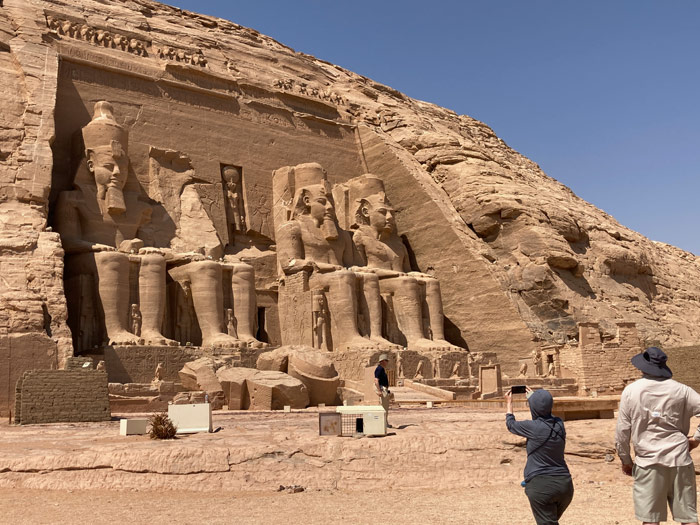What bliss to “go with the flow,” as I did recently, especially delightful as the “flow” is Egypt’s Nile River and I was aboard the Zein Dahabeya, Abercrombie & Kent’s luxuriously reconfigured sailing boat, during a two-week trip to Egypt and Jordan.
On board the yacht, with cabins for only 12 people, my small group of six was treated to delicious over-abundant meals and attentive friendly service from the staff as we floated for four days between Luxor and Aswan. One evening, especially for us, the crew hoisted the sails which originally powered the boat.









Frustrated not being able to take a photo, the ever-accommodating boat manager Khalid put us aboard the accompanying tugboat so we could circle around and snap away.
During the journey, we passed through the lock at Esna and explored some of the awe-inspiring wonders of ancient Egypt, including the temples at Karnak and Luxor, the tombs in the Valley of the Kings, and a carriage ride to the Temple of Horus at Edfu.







Our excellent guide, Mohammed, deluged us with information and statistics, some of which I managed to absorb, including the great trivia fact that there are 14 million Egyptian men named Mohammed. So if ever in doubt, try “Mohammed” and you’ll probably be right.



In Aswan we reluctantly left the boat, but were delighted to move on to the Old Cataract Hotel, famous in fact and fiction. Built in 1899, it is wonderfully situated by the river, and awash in atmosphere. (A 1978 movie of Agatha’s Christie’s novel, Murder on the Nile, was partially filmed there. Fun to watch and a great cast.)





In Aswan, at a vast granite quarry, we were fascinated to see a partially finished obelisk in the rock. A crack found made it unusable so it was never completed, but 3500 years later we were lucky be able to see it close up.
How the ancient Egyptians managed to carve, build, transport and erect these monumental structures and figures has been the subject of endless speculation. Some suggest it had to crafted by extraterrestrials, which seems to me the only reasonable explanation!

We took a small boat to the well-preserved Philae Temple on the island of Agilika and a sunset sail in a felucca.


We had a somewhat pretentious dinner in the famous, but empty 1902 Restaurant at the hotel. The meal was delicious but pretending to live grandly as they did 100+ years ago was a little embarrassing. Passing thorough the awninged porch which overlooks the gardens and the Nile, where people were comfortably sitting for dinner, seemed much more appealing to me.

Toward the end of the trip, we flew to Abu Simbel to see two massive and masterfully carved temples. There are photos which show the truly monumental task of moving them from the edge of Lake Nasser (the largest lake in the world) as it flooded after the great dam was built. The pictures are from the 1960s so this time we know for sure it wasn’t aliens who accomplished the feat.








Our last day was spent in and about the Great Pyramids in Giza. When our guide described the low, narrow and steep passages leading to King Khufu’s burial chamber in the middle of the great pyramid, it was with some trepidation that we clambered up the huge stone blocks to the rough entrance to the tomb. Not nearly as challenging as we feared, we were exhilarated to have done it!














Before Egypt, my trip included Jordan, also fascinating and rife with biblical references.

Petra was, of course, a highlight. Jerash, a Greco-Roman city thriving in 249 AD, outside Amman, has enough remains of columns, theatres, stairways to temples, to easily imagine charioteers dashing through the main street.







In Jerash, I came upon three Jordanian Army musicians playing “Yankee Doodle” with drums and a bagpipe! What a great surprise! Who knew the bagpipe was invented in Mesopotamia before the Scots thought of it?


We saw the Red Sea from Aqaba, and the Dead Sea which was an adventure, smearing ourselves with the restorative mud. My skin felt soft for days. But it was a very odd feeling, trying to get a footing as the water is so salty that you have to fight to not float; maybe the weightless astronauts feel the same. Sadly, the Dead Sea is receding rapidly. Jordan, a very dry country, is also suffering from a current drought so the government is preventing what water they have from flowing back into the Dead Sea.


My only frustration on the trip was the impossibility of showing the colossal enormity of the structures and statues. People are so small and the temples, figures, and columns are so BIG. You just have to go and see it for yourself.
Upon returning to New York, I was greeted by a funny sign in the JFK Delta terminal: I haven’t been everywhere, but it’s on my list.
Me, too!
"flow" - Google News
November 16, 2021 at 10:56AM
https://ift.tt/3kFOyd6
Going with the flow of the Nile - newyorksocialdiary.com
"flow" - Google News
https://ift.tt/2Sw6Z5O
https://ift.tt/2zNW3tO
Bagikan Berita Ini














0 Response to "Going with the flow of the Nile - newyorksocialdiary.com"
Post a Comment